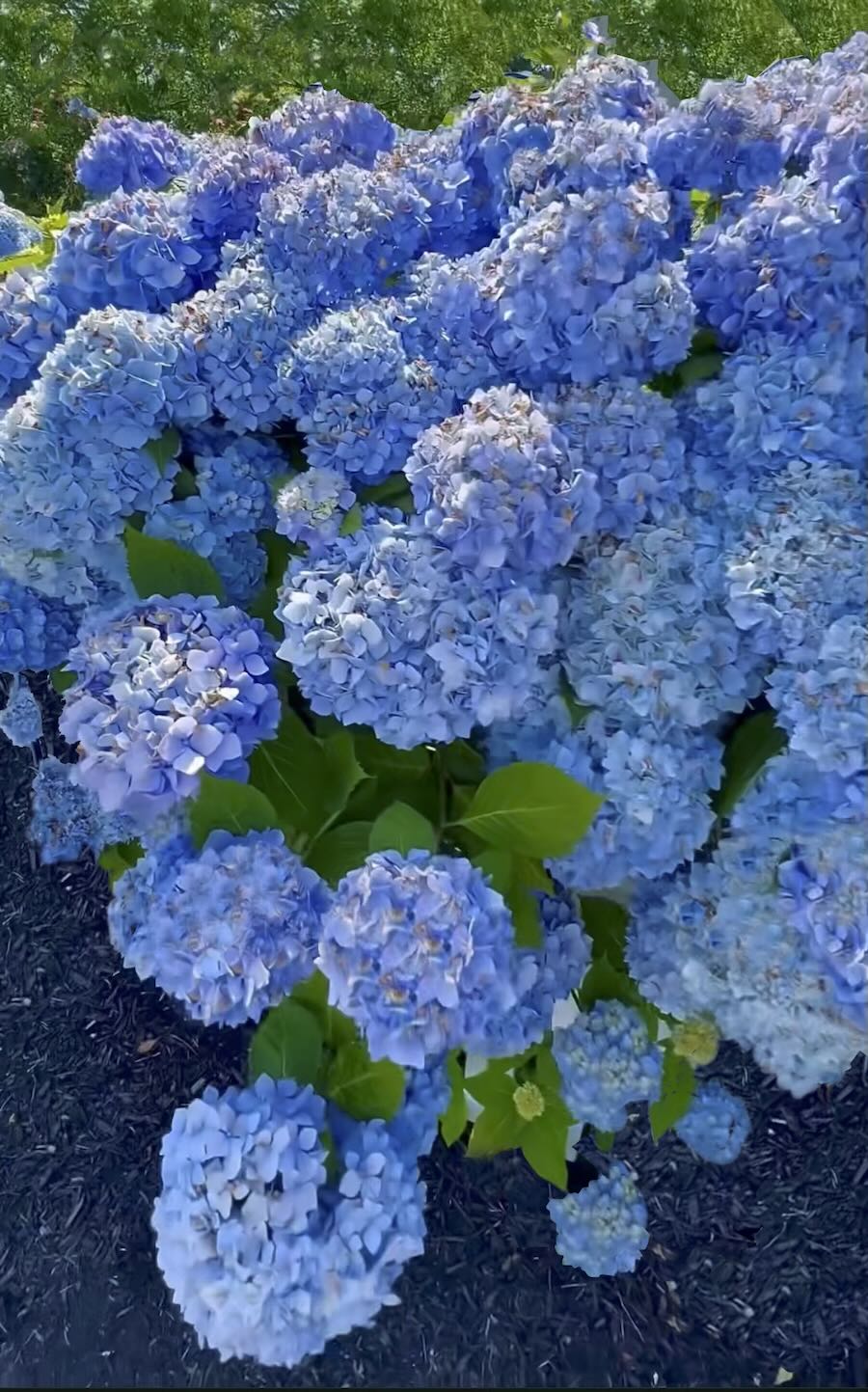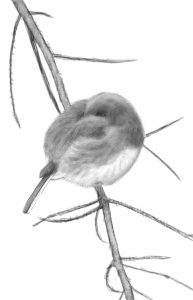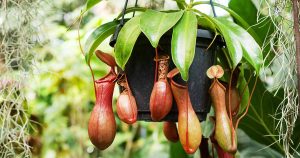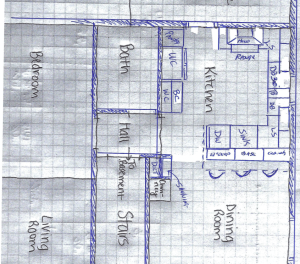
IT’S HYDRANGEA SEASON, and in the Northeast in particular this summer, it’s really been a crazy hydrangea season, with billows of blue bloom from bigleaf hydrangeas on view everywhere, it seems—which is not always the case in colder hardiness zones. It seemed like a good time to review what makes hydrangeas happy, and what hydrangeas make me and my old friend, Ken Druse, happy.
Hydrangea-loving Ken Druse, who gardens in New Jersey, is the author of 20 garden books ranging in topic from shade gardening and plant propagation to fragrance in the garden and more. He’s my co-host of the Virtual Garden Club series of online classes that we offer in fall, winter, and early-spring semesters. I’m always glad for any excuse to talk plants with him any time.
Read along as you listen to the July 29, 2024 edition of my public-radio show and podcast using the player below. You can subscribe to all future editions on Apple Podcasts (iTunes) or Spotify (and browse my archive of podcasts here).
a bountiful hydrangea season, with ken druse
Margaret Roach: Hi, Ken. How are you?
Ken Druse: Hi, Margaret. I’m O.K. I think I’ve gotten over what one person might call summer, so far. [laughter]. We’ve had a lot of heat.
Margaret: A lot of places in the country, certainly. I was doing an interview with someone for a “New York Times” story, a climatologist, and I was looking at the heat maps. The National Oceanic and Atmospheric Association, NOAA, puts out a heat map every month; sort of the summary, so to speak. It was like psychedelic, you know what I mean? [Laughter.] It was like, oh boy. Was there one quarter of a millimeter of land that wasn’t? Not uplifting.
So tell the truth before we get started, how many hydrangeas, including all different species, how many hydrangeas do you have there in New Jersey, in that garden?
Ken: Maybe 50, maybe.
Margaret: [Laughter.] Wow. That’s a lot of hydrangeas. I was thinking about it before getting on the line with you here today, and I was thinking, I think I have eight or nine, almost, maybe five of paniculatas, and four oakleafs, and I don’t have anything else. And frankly, I’ve never grown a blue hydrangea, a mophead or a bigleaf.
Ken: Well, I’ll tell you a familiar story. I went to visit a gardener friend of mine in Pennsylvania, not too far from here, and her hydrangeas, she had two shrubs, and they were gorgeous. They had giant leaves. They were about 5 feet tall and 5 feet wide. And they had between these two shrubs two flowers, and it made sense. And this woman’s a seasoned gardener, so I asked her about it and she said, “Well, I cut them back. They never bloom.” [Laughter.] And it’s not that they never bloom because she cuts them back. She cuts them back because they never bloom. And so she had these nice big shrubs. But this year is different.
And every blue, or pink, I could say that, too, the macrophylla, sometimes called mophead, and macrophylla means big leaf, and that is the bigleaf Hydrangea macrophylla, which is what most people associate with hydrangeas. And if you live by the seashore or if you’re in a zone 7 or better climate, even though these plants are hardy to 5, zone 5, they won’t die, but they also won’t flower.
Here in my garden, they don’t flower because even though they make buds in summer, the buds don’t make it through the winter; they burn. And I think it’s because they don’t have a long enough season to ripen the buds. So I just get these brown dried-up things. And so did she.
Margaret: So in the Northeast, it’s been in every media report and every radio station, every newspaper, whatever, throughout the Northeast, it’s been this thing. It’s been like this hydrangea moment of the blue ones, of, as you say, the macrophyllas, the mopheads. And as you’re just sort of hinting at, when you have a good year or a bad year, it’s not magic. It’s because of climate/weather factors, right? I mean there’s…
Ken: A milder winter, or two, and moisture at the right time. And people say, “Oh, I haven’t seen hydrangeas like this for 10 years.” I’ve never seen hydrangeas like this.
Margaret: Right.
Ken: In 30 years.
Margaret: Well, and what else… In our region, and actually in some other northern parts of the country, too, I’m not talking about the hydrangeas, but in general, we have all been, as gardeners, speaking to one another saying, “Oh my goodness, I’ve never had blank happen so early or so…” Do you know what I mean?
Ken: “Have you ever seen hydrangeas like this?” And the blue is, people say, electric blue. Well, I don’t know how to describe it except electric blue. They’re blinding, they’re incredible.
Margaret: But aside from hydrangeas, people have noted, gardeners have noted, and it’s been the conversation since… Spring started very early, for instance, in the Northeast as well. And we had a very mild winter in the Northeast. So it’s not just hydrangeas that are among all the creatures that live outside and have to withstand the various insults of climate and weather [laughter]. It’s not just the hydrangeas. It’s all the plants and animals whose populations are reacting to-
Ken: And you had a garden tour this year, too, and I had one, and this year, I don’t have a lot of parking spaces, so I auction off garden tours for charity usually. And I looked back in history, and I remember the garden tour peak was the first week in June. Then it was the last week in May. Then it was May 23rd was always the big day. And then it was… I think next year it’s going to be May 11th.
Margaret: Yes. And so that’s what I’m saying is that it’s not that the hydrangeas are doing something idiosyncratic of the rest of the natural world in a given location. They are just showing it in this vivid, as you say, electric-blue manner. And frequently they’re big shrubs and they’re frequently planted en mass, so we’re noticing it.
But what we’re noticing is a sign of the times. And we’re noticing that, like Boston, for instance, I looked up the weather data for Boston. Boston only got to 14 degrees Fahrenheit was the low for last winter, whereas the winter before, minus-10 was the low. So if you’re a Hydrangea macrophylla, you’re going to like last winter in terms of keeping your buds alive, your buds that are produced on the old wood that are going to be carried over the winter. You’re going to like that a lot better than you’re going to like the one before when it was minus-10, which is going to kill a lot of those.
Ken: You know how nurseries ask you to put in your Zip code to tell you what zone you’re in?
Margaret: Yeah.
Ken: Well, it used to always be 6a. And now, I did that recently, and I’m in 6b. I didn’t move at all [laughter].
Margaret: You didn’t move. But the USDA did issue the whole new hardiness zone map. Most of us moved to half a zone, so yes, yes. I’m a 6a now, and I was a 5a when I got here years and years and years ago. And I was a 5b most of the time, and now I’m a 6a.
And so you said earlier, the bigleaf hydrangeas, part of the reason I never grew them, there’s two reasons I never grew one. Literally, I’ve never grown one, which is kind of weird considering how popular they are and how long I’ve been gardening.
But blue is not a color that I’m into at all. And I know that’s heresy to say that to an audience of gardeners [laughter], but other than Mertensia virginica, the Virginia bluebells of the woodland floor in spring, I just am not a blue person. It doesn’t go with my thing, my color palette, my eye, whatever. So I don’t have anything that’s blue. And so that was one. But the other thing, and more important, was that they frankly were not rated for my zone. Again, in the beginning when I was first here, I was a cold zone 5, and then I was a so-called warm zone 5, but still, they were always considered marginally hardy. Not that the plants would die, as you said before, but that you wouldn’t get flowering. So why grow a flowering shrub if you don’t get any flowers?
Ken: Now you tell me [laughter].
Margaret: Yeah, O.K.
Ken: Well, we do a lot of experimenting here, and people send me plants and I plant them. And as you’re saying that, I got some ‘Endless Summer’ hydrangeas a few years ago, which bloom on old wood and new wood. The growth that happens during this season will bloom starting around now. And I didn’t get two blooms. I only got one bloom, and it was the late summer bloom. Well, this year I got both blooms. So this thing has been in bloom probably since June, flower after flower, and it’s in bloom now, which is July that feels like August.
Margaret: Yes. So the thing is, and what you just brought up, is that there’s different genetics also out there in the world of even this one species, Hydrangea macrophylla. Even among the mophead hydrangeas, there’s lots of new genetics in recent decades out there in the market that have been bred and then introduced and so forth and popularized and are now growing to adulthood, so to speak, in people’s gardens in larger numbers. So that’s another factor. There are hardier ones, because the things that they’ve been bred for were improved hardiness and reliable flowering, to extend the range of the big blue hydrangea. So that’s also taking effect. That’s also part of what we’re seeing. And there are more choices that are hardier.
Ken: There’s a lot of hydrangeas that are called ‘Endless Summer,’ and there’s different varieties of them now.
Margaret: Yes.
Ken: And sometimes you can’t even find one that doesn’t say ‘Endless Summer.’
Margaret: Yeah, no, I know. But the funny thing about them, as you just said, those are ones that are blooming on new… Well, old and new wood, but the new wood buds come to fruition, they flower in the second part of the season, yes? Did I get that right?
Ken: Yeah, they kind of overlap here.
Margaret: But they start a little later than the…
Ken: Right.
Margaret: Right. So the thing about those is that they may be at a very vulnerable, tender stage when late freezes happen late in spring. If we were to have in May a really serious freeze, not just a little bit of a frost, but a serious freeze, those can get banged up, too. So you know what I mean? There’s a lot going on outside right now for all plants to withstand. It’s a brave new world, I think [laughter].
Ken: Well, you’re making me think of all the things that people ask about the macrophyllas. And the main thing that we always got asked is, “How come my Hydrangea macrophylla don’t bloom?” And it was almost always because… At first I’d say, “When do you prune them?” And they’d say, “Oh, I prune them in the spring.” “Well, you’re cutting off the buds.”
But I’ve been doing a little research on the ‘Endless Summer,’ and I’ve read that one should deadhead them, which is cut off the first set of blooms, just from the flower down to the first set of leaves, as the flowers are fading. And then don’t cut the second set of blooms, because they dry and protect the buds. So that’s different.
But what I always did with my macrophyllas, whether they bloomed or not, was just keep cutting out the dead wood, which is pretty easy to see because it’s usually straw-colored and the canes, if we can call them canes, they last about three years, and then they get papery. And if they bloom, they’ll only have tiny flowers and lots of them. And you want the big ,voluptuous blooms if you can get them.
Margaret: Not the tired old canes that are producing maybe a little something.

And the second year, the flowers are smaller and they stand up. But that’s an incredibly great plant. And then, I don’t know, five or six years ago, kaboom! Now there’s maybe a dozen pink ones and a dozen white ones, and we’re not too fond of what we could call “double” hydrangeas at all, because they have fewer, if any, fertile flowers for pollinators. But you were telling me that Mt. Cuba Center did a test on those hydrangeas.
Margaret: Yes, on the arborescens, on the smooth hydrangeas. Yes, they did. And the one that I’m coveting, and actually I just removed some things; I’m reworking a couple of long-neglected areas, some of the oldest parts of the garden as is necessary every 500 years [laughter]. You look at it, and you look at it, and you look at it year after year and you’re like, “Oh, that needs fixing. Oh, that needs reno-. Oh, that needs…” And then finally, I don’t know what, it just gets into you and you do it. Do you know? And so a bunch of stuff got yanked out, and the space is there, and I’m adding… One of the ones that I covet to add was the one that Mt. Cuba rated the most highly in terms of its overall performance, and especially its pollinator interaction, which was ‘Haas’ Halo.’ [Below.]
And it’s just lovely, and I had recommended it to my neighbor a year or two ago, and she has it just up the hill from me, and it’s fabulous. And it’s just literally abuzz. It’s so visited by insects right at this time of year in the summer, and it’s a great plant. And there’s lots of other ones, as you just pointed out. So I’ve just made a space, I haven’t got the plants yet, because it’s been so hot and dry. I didn’t want to do a lot of planting and watering, so I thought, you know what? I’m going to put them in in September or something. So I’m looking for specimens.

Margaret: Oh, interesting.
Ken: I was going to say, if you’d like six or 12…
Margaret: Oh, O.K., good. So mail them to me. That’d be fine. I’ll pay the postage.
So you’ve mentioned a couple of times just now the sterile and fertile flowers and so forth, and the hydrangeas have bracts. It looks like a flower petal, but it’s not a petal. And those do, they sort of say, “Hey, look at me. I’m showy.” I think they can help guide insects in. But when you have only those, like with ‘Annabelle’ that we talked about before, or like with the classic big blue hydrangeas of the past, when there wasn’t as much choice, they were all mopheads, right? There were fewer nectar resources for visiting insects and so forth, because you didn’t have as many female flowers; proportionately you didn’t have many female flowers. The female flowers are more like a little bead. They’re just tiny.
And I love the lacecaps. In all the species, that’s what I want. So for instance, in my paniculatas, I don’t have any of the ones that look like the peegee [paniculata ‘Grandiflora’], the big, big… I have only ones that have lacecappy kind of… They’re a different shape of flower. It’s more like a big, I don’t know what you would even call it, like a big football [laughter]. But I like ones like ‘Tardiva’ [detail below] and just straight paniculata, the ones that have the lacecap arrangement, because they’re just so much more loaded with pollinators.
Ken: Those aren’t flat. They’re more like conical usually.
Margaret: Exactly. That’s what I’m saying. It’s almost like a football, but only pointed on one end.
Ken: Pointed, right?

Ken: Paniculatas are really hardy, and you can cut them back in the late winter or very early spring, because they bloom on new growths. And you don’t have to cut them to the ground; you can just keep them to the size you’d like. And there’s one here called ‘Limelight,’ which appears to be “double” or sterile, but the bees climb in. And I’ve seen the… There’s lots going on in there. Here it is almost the end of July. And the flowers, they’re green on ‘Limelight,’ but they’re completely out. The panicle hydrangeas are really happening. So from ‘Brussels Lace’ and ‘White Moth.’ ‘Brussels Lace’ is sort of over, and all the way to ‘Tardiva,’ that’s a really long season of having a range of paniculata, which is practically carefree. I guess maybe we get Japanese beetles. I don’t know.
Margaret: No, it’s my favorite. I love them. Some are just starting right now, barely. They’re going to start in the next week or two. They’re a little late. And that’s on me because I pruned them late. They had already really started; there was a little bit of budding happening, so I set them back about two weeks, because I clipped off a little growth.
Ken: That could make them normal this year, because everything’s so early [laughter].
Margaret: Possibly, but yeah. So that’s fine. But yes, so anyway, I’m kind of obsessed with the lacecaps. And you’re right, there are nectar resources, there is pollen, and there is nectar. There are these resources within the big double-looking flowers. They’re not the bigger part of the picture, they’re minority players, so to speak.
I wonder, are there any other hydrangeas that you want to shout out that you’ve added in your 90…? What did he say [laughter]?
Ken: Fifty. Only 50.
Margaret: Oh, sorry. Any other species that you’re playing around with that you’re excited about?
Ken: Oh, no, you’re putting me on the spot.
Margaret: No, no, it’s fine. The answer could be no.

Margaret: Yes. It’s kind of a reddish-purplish [above]; I don’t even know what. It’s beautiful.
Ken: Maroon, burgundy some years.
Margaret: Gorgeous.
Ken: It’s different every year.
Margaret: I just added two more of those. And that’s the other thing I’m adding more of. I’m adding more of those. They’re so carefree. I think they’re carefree and…
Ken: And shade-tolerant, more than the others.
Margaret: And that’s what I was going to say. And this one area that I’m reworking, one of the areas I’m reworking, is a little bit more filtered. It’s bright shade, but it’s not full sun. And so I think they’re really happy in that area. I have a couple already in there, and I’m putting more.

And I think I’ve got one, and I’m not completely sure about this, but I’m not out there looking at the label, Hydrangea involucrata, which has a really very strange and wonderful… Oh, the asperas [above]. I didn’t even think of that. Hydrangea aspera, which is a plant five years ago, 10 years ago I would never grow it, because it’s a zone 7 plant. Well, apparently it’s not. Because I have two. They have fuzzy leaves, beautiful flowers. Oh, beautiful flowers, single flowers. It’s hard to describe. Has a lump of the fertile flowers surrounded by a crown of sterile flowers. If you can picture it.
Margaret: That’s another good point is that when something’s newer to the market, like the asperas where they were in specialty catalogs, rare-plant catalogs, and then they started to get a little more and a little more and a little more distribution. There’s just not the data on what’s hardy where until enough people are growing it in enough places, botanic gardens as well as consumers. Do you know what I mean? So they make a guess at hardiness, but they can’t be sure.
Ken: They think about where did this plant come from?
Margaret: Correct. Correct.
Ken: Where does it grow in nature?
Margaret: Correct.
Ken: And that’s how they did it, when plants were new. But things have changed.
Margaret: Well definitely.
Ken: I can’t say people should go out and try everything, but I would say go out and try everything.
Margaret: Yeah, because you’re a nut. So I just want to say, obviously at this time of year… I’m a shrub and tree lover, but especially shrubs, and at this time of year, there are other things, too, that make me really happy when they come on in the garden, not just hydrangeas.
And one that I just want to do a quick shoutout for is, they started around the 4th of July, and now my later ones are blooming, are the bottlebrush buckeyes, the Aesculus parviflora [above], another Southeastern native, like the oakleaf hydrangea, and I just can’t believe the number of insects that find their way to those blooms and enjoy them. And the yellow fall color of the leaves that I’m looking forward to then in September, October. Just a great plant. Huge. They’re big, big, big plants. But do you have anything else that’s looking good right now?
Ken: Well, I know that we’re talking about woody plants, and I have not paid enough attention to Clethra.
Margaret: See, there’s one exactly that we should just shout it out and say, “Hey, why don’t we all do a little homework on Clethra?” Exactly. Exactly.

Margaret: So those are just two more for summer color from your shrubs. So that’s what we’re really encouraging. And we’ve run out of time, and I’m going to say goodbye to you, Ken, although we could talk about plants forever, as I think is obvious listening to us [laughter]. So I’ll talk to you soon, O.K.?
Ken: Thanks, Margaret.
prefer the podcast version of the show?
MY WEEKLY public-radio show, rated a “top-5 garden podcast” by “The Guardian” newspaper in the UK, began its 15th year in March 2024. It’s produced at Robin Hood Radio, the smallest NPR station in the nation. Listen locally in the Hudson Valley (NY)-Berkshires (MA)-Litchfield Hills (CT) Mondays at 8:30 AM Eastern, rerun at 8:30 Saturdays. Or play the July 29, 2024 show using the player near the top of this transcript. You can subscribe to all future editions on iTunes/Apple Podcasts or Spotify (and browse my archive of podcasts here).










